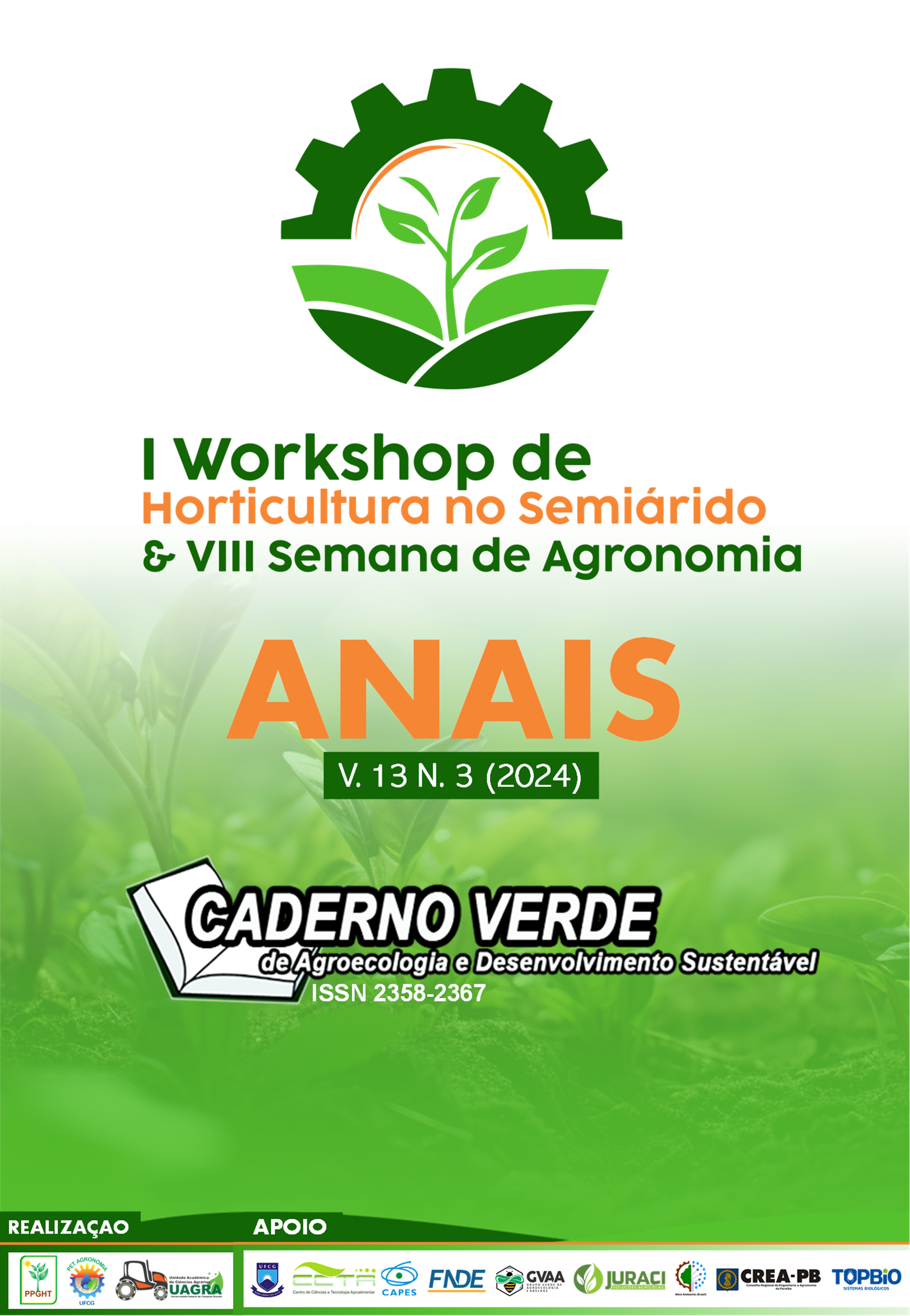Pigmentos fotossintéticos de pepineiro sob cultivo hidropônico em soluções nutritivas salinas e aplicação foliar de ácido ascórbico
Keywords:
Cucumis sativus L., fitormônio, cultivo sem soloAbstract
The use of brackish water in the semiarid region is an alternative for production during periods of water scarcity. However, in order to use these waters, it is essential to establish strategies to identify the effects of saline stress on plants. In this context, the objective of this research was to evaluate the effects of foliar application of salicylic acid on the photosynthetic pigment levels of Japanese Hiroshi cucumber plants grown with saline nutrient solution in a NFT hydroponic system. The experiment was developed under field conditions in Pombal-PB, using the hydroponic system with the Laminar Nutrient Flow Technique - NFT. The experimental design was completely randomized, in a split-plot scheme, whose treatments consisted of four saline levels of the nutrient solution - CEsn (2.1, 3.6, 5.1, and 6.6 dS m-1) and two concentrations of salicylic acid (0 and 4.5 mM) with three replicates and two plants per plot. The salinity of the nutrient solution from 2.1 dS m-1 did not inhibit the synthesis of photosynthetic pigments of Japanese Hiroshi cucumber plants.
References
AGATEMOR, U. M. M.; NWODO, O. F. C.; ANOSIKE, C. A. Phytochemical and proximate composition of cucumber (Cucumis sativus) fruit from Nsukka, Nigeria. African Journal of Biotechnology, v.17, p.1215-1219, 2018.
ARNON, D. I. Copper enzymes in isolated cloroplasts: polyphenol oxidases in Beta vulgaris. Plant Physiology, v.24, p.1-15, 1949.
CRUZ, A. F. S.; SILVA, G. F.; SILVA, E. F. F.; SOARES, H. R.; SANTOS, J. S. G.; LIRA, R. M. Stress index, water potentials and leaf succulence in cauliflower cultivated hydroponically with brackish water. Revista Brasileira de Engenharia Agrícola e Ambiental, v.22, p.622-627, 2018.
FERREIRA, D. F. SISVAR: A computer analysis system to fixed effects split-plot type designs. Revista Brasileira de Biometria, v.37, p.529-535, 2019.
GUIMARÃES, R. F. B.; MAIA JÚNIOR, S. O.; LIMA, R. F.; SOUZA, A. R.; ANDRADE, J. R.; NASCIMENTO, R. Growth and physiology of ornamental sunflower under salinity in function of paclobutrazol application methods. Revista Brasileira de Engenharia Agrícola e Ambiental, v.25, p.853-861, 2021.
HOAGLAND, D. R.; ARNON, D. I. The water-culture method for growing plants without soil. Berkeley: University of California, Circular. California Agricultural Experiment Station, v.347, n.2, 39. p., 1950.
LIMA, B. R.; OLIVEIRA, E. P.; DONATO JÚNIOR, E. P.; BEBÉ, F. V. Uso e qualidade de água subterrânea utilizada por agricultores familiares no Território Sertão Produtivo, Estado da Bahia, Nordeste do Brasil. Revista Brasileira de Gestão Ambiental e Sustentabilidade, v.7, p.679-689, 2020.
LIRA, R. M.; SILVA, Ê. F. F.; SILVA, G. F.; SOARES, H. R.; WILLADINO, L. G. Growth, water consumption and mineral composition of watercress under hydroponic system with brackish water. Horticultura Brasileira, v.36, p.13-19, 2018.
MEDEIROS, J. F. Qualidade da água de irrigação e evolução da salinidade nas propriedades assistidas pelo "GAT" nos Estado do RN, PB e CE. Campina Grande: UFCG. 1992. 196 f. Dissertação (Mestrado em Engenharia agrícola) Universidade Federal de Campina Grande, Campina Grande. 1992.
MENDONÇA, A. J. T.; SILVA, A. A. R. da; LIMA, G. S. de; SOARES, L. A. dos A.; OLIVEIRA, V. K. N.; GHEYI, H. R.; LACERDA, C. F. de.; AZEVEDO, C. A. V. de.; LIMA, V. L. A. de.; FERNANDES, P. D. Salicylic acid modulates okra tolerance to salt stress in hydroponic system. Agriculture, v.12, p.1687, 2022.
SILVA, A. A. R. da; LIMA, G. S. de; AZEVEDO, C. A. V. de; VELOSO, L. L. de S. A.; GHEYI, H. R. Salicylic acid as an attenuator of salt stress in soursop. Revista caatinga, v.33, p.1092-1101, 2020. SOARES, L. A. dos A.; OLIVEIRA, S. G. de; LIMA, G. S. de; FERNANDES, P. D.; ARAÚJO, R. H. C. R.; FERNANDES, E. A. Physiological changes of pomegranate seedlings under salt stress and nitrogen fertilization. Revista Brasileira de Engenharia Agrícola e Ambiental, v.25, p.453-459, 2021.
TAIBI, K.; TAIBI, F.; ABDERRAHIM, L. A.; ENNAJAH, A.; BELKHODJA, M.; MULET, J. M. Effect of salt stress on growth, chlorophyll content, lipid peroxidation and antioxidant defence systems in Phaseolus vulgaris L. South African Journal of Botany, v.105, p.306-312, 2016.
UTHPALA, T. G. G.; MARAPANA, R. A. U. J. Study on nutritional composition on firmness of two gherkin (Cucumis sativus L.) varieties (Ajax and Vlasset) on brine fermentation. American Journal of Food Science and Technology, v.5, p.61–63, 2017.
Downloads
Published
How to Cite
Issue
Section
License
Copyright (c) 2024 Valeska Karolini Nunes Oliveira de Sá et al.

This work is licensed under a Creative Commons Attribution 4.0 International License.
Termo de cessão de direitos autorias
Esta é uma revista de acesso livre, em que, utiliza o termo de cessão seguindo a lei nº 9.610/1998, que altera, atualiza e consolida a legislação sobre direitos autorais no Brasil.
O(s) autor(es) doravante designado(s) CEDENTE, por meio desta, publica a OBRA no Caderno Verde de Agroecologia e Desenvolvimento Sustentável, representada pelo Grupo Verde de Agroecologia e Abelhas (GVAA), estabelecida na Rua Vicente Alves da Silva, 101, Bairro Petrópolis, Cidade de Pombal, Paraíba, Brasil. Caixa Postal 54 CEP 58840-000 doravante designada CESSIONÁRIA, nas condições descritas a seguir:
O CEDENTE declara que é (são) autor(es) e titular(es) da propriedade dos direitos autorais da OBRA submetida.
O CEDENTE declara que a OBRA não infringe direitos autorais e/ou outros direitos de propriedade de terceiros, que a divulgação de imagens (caso as mesmas existam) foi autorizada e que assume integral responsabilidade moral e/ou patrimonial, pelo seu conteúdo, perante terceiros.
O CEDENTE mantêm os direitos autorais e concedem à revista o direito de divulgação da OBRA, com o trabalho simultaneamente licenciado sob a Licença Creative Commons do tipo atribuição CC-BY.
O CEDENTE têm autorização para distribuição não-exclusiva da versão do trabalho publicada nesta revista.
O CEDENTE têm permissão e são estimulados a publicar e distribuir seu trabalho online (ex.: em repositórios institucionais ou na sua página pessoal) a qualquer ponto antes ou durante o processo editorial, já que isso pode gerar alterações produtivas, bem como aumentar o impacto e a citação do trabalho publicado.








